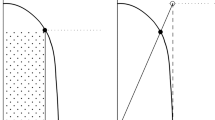Abstract
In this paper we present a different perspective than the more traditional approaches to study solutions for multi-issue allocation problems. This perspective is based on a direct sum decomposition for the vector space of these problems by identifying those subspaces that are relevant to the study of linear symmetric solutions. We then use such decomposition to derive some basic applications involving characterizations of several classes of solutions. Finally, we present a brief set of results relating coalitional game theory and multi-issue allocation problems.
Similar content being viewed by others
Notes
The precise results will be provided in Sects. 4.
In general, a subspace W of \( \mathbb {R} ^{n}\) or \(MIA^{(n)}\) is invariant (for the action of \(S_{n}\)) if for every \( w\in W\) and every permutation \(\theta \in S_{n}\) we have that \(\theta \cdot w\in W\).
Formally, a solution f is reallocation-proof if for each \(\left( A,b\right) \in MIA^{\left( n\right) }\), each \(S\subseteq N\), and each \( A^{\prime }\in \mathbb {R} ^{M\times N}\), if \(\sum _{j\in S}C_{j}^{A^{\prime }}=\sum _{j\in S}C_{j}^{A}\), then \(\sum _{j\in S}f_{j}\left( C_{S}^{A^{\prime }},C_{N\backslash S}^{A},b\right) =\sum _{j\in S}f_{j}\left( A,b\right) \).
For instance, Ju et al. (2007) consider the same axioms under the names of anonymity and equal treatment of equals, respectively.
Here, we follow a similar approach presented in O’Neill (1982) in the sense that a coalitional game is derived from a MIA problem and then apply a solution for the associated game.
For a brief revision of the concepts of solutions for coalitional games that are mentioned here, such as the Shapley value, see Peleg and Sudhölteer (2007).
This is the set of efficient payoff vectors such that each coalition receives at least its worth (group rationality).
For instance, see Olvera-López and Sánchez-Sánchez (2011).
References
Aumann R, Maschler M (1985) Game theoretic analysis of a bankruptcy problem from the Talmud. J Econ Theory 36:195–213
Bergantiños G, Chamorro J, Lorenzo L, Lorenzo-Freire S (2018) Mixed rules in multi-issue allocation situations. Nav Res Logist 65(1):66–77
Bergantiños G, Lorenzo L, Lorenzo-Freire S (2011) New characterizations of the constrained equal awards rule in multi-issue allocation situations. Math Methods Oper Res 74:311–325
Bergantiños G, Méndez-Naya L (2001) Additivity in bankruptcy problems and in allocation problems. SpanEconRev 3:223–229
Calleja P, Borm P, Hendrickx R (2005) Multi-issue allocation situations. Eur J Oper Res 164(3):730–747
González-Alcón C, Borm P, Hendrickx R (2007) A composite run-to-the-bank rule for multi-issue allocation situations. Math Methods Oper Res 65:339–352
Hernández-Lamoneda L, Juárez R, Sánchez-Sá nchez F (2007) Dissection of solutions in cooperative game theory using representation techniques. Internat J Game Theory 35(3):395–426
Herrero C, Maschler M, Villar A (1999) Individual rights and collective responsibility: the rights-egalitarian solution. Math Soc Sci 37:59–77
Hinojosa M, Mármol A, Sánchez F (2012) A consistent talmudic rule for division problems with multiple references. TOP 20:661–678
Hinojosa M, Mármol A, Sánchez F (2013) Extended proportionality in division problems with multiple references. Ann Oper Res 206(1):183–195
Ju B-G, Miyagawa E, Sakai T (2007) Non-manipulable division rules in claim problems and generalizations. J Econ Theory 132(1):1–26
Kleinberg NL, Weiss JH (1985) Equivalent n-person games and the null space of the Shapley value. Math Oper Res 10(2):233–243
Kleinberg NL, Weiss JH (1986) Weak values, the core and new axioms for the Shapley value. Math Soc Sci 12:21–30
Lorenzo-Freire S, Casas-Méndez B, Hendrickx R (2010) The two-stage constrained equal awards and losses rules for multi-issue allocation situations. TOP 18:465–480
Marmol A, Ponsati C (2008) Bargaining over multiple issues with maximin and leximin preferences. Soc Choice Welfare 30:211–223
O’Neill B (1982) A problem of rights arbitration from the Talmud. Math Soc Sci 2(4):345–371
Olvera-López W, Sánchez-Sánchez F (2011) About incentives distribution. Appl Math Sci 5(49):2411–2423
Peleg B, Sudhölteer P (2007) Introduction to the theory of cooperative games, 2nd edn. Springer, Berlin
Sánchez-Pérez J (2019) Solutions for network games and symmetric group representations. Oper Res Decis 29(4):95–123
Sánchez-Pérez J (2017) A decomposition for the space of games with externalities. Internat J Game Theory 46(1):205–233
Sánchez-Pérez J, Plata-Pérez L, Accinelli-Gamba E (2015) Characterization of linear symmetric solutions for allocation problems. Econ Lett 130:9–12
Shapley L (1953) A value for n-person games. Contribution to the theory of games; annals of mathematics studies, vol 2. Princeton University Press, Princeton, pp 307–317
Shapley L (1971) Cores of convex games. Internat J Game Theory 1(1):11–26
Svensson L, Torstensson P (2008) Strategy-proof allocation of multiple public goods. Soc Choice Welfare 30:181–196
Author information
Authors and Affiliations
Corresponding author
Additional information
Publisher's Note
Springer Nature remains neutral with regard to jurisdictional claims in published maps and institutional affiliations.
Rights and permissions
About this article
Cite this article
Sánchez-Pérez, J. New results for multi-issue allocation problems and their solutions. Rev Econ Design 27, 313–336 (2023). https://doi.org/10.1007/s10058-022-00293-8
Received:
Accepted:
Published:
Issue Date:
DOI: https://doi.org/10.1007/s10058-022-00293-8




